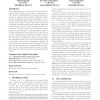158 search results - page 17 / 32 » Community Learning by Graph Approximation |
TIP
2008
13 years 7 months ago
2008
This paper presents recursive cavity modeling--a principled, tractable approach to approximate, near-optimal inference for large Gauss-Markov random fields. The main idea is to su...
KDD
2006
ACM
14 years 8 months ago
2006
ACM
Several algorithms have been proposed to learn to rank entities modeled as feature vectors, based on relevance feedback. However, these algorithms do not model network connections...
EMNLP
2011
12 years 7 months ago
2011
We consider the problem of performing learning and inference in a large scale knowledge base containing imperfect knowledge with incomplete coverage. We show that a soft inference...
NN
1997
Springer
13 years 11 months ago
1997
Springer
Bayesian networks are directed acyclic graphs that represent dependencies between variables in a probabilistic model. Many time series models, including the hidden Markov models (H...
ESOP
2011
Springer
12 years 11 months ago
2011
Springer
Abstract. The Bayesian approach to machine learning amounts to inferring posterior distributions of random variables from a probabilistic model of how the variables are related (th...

